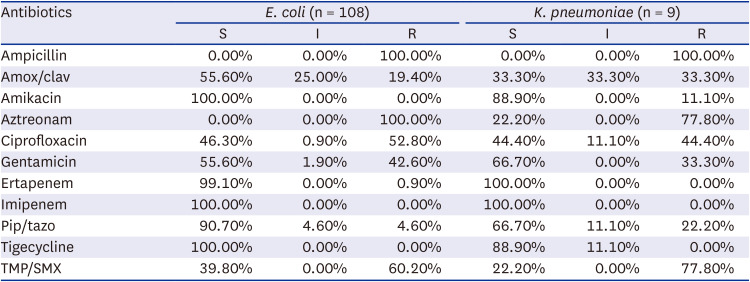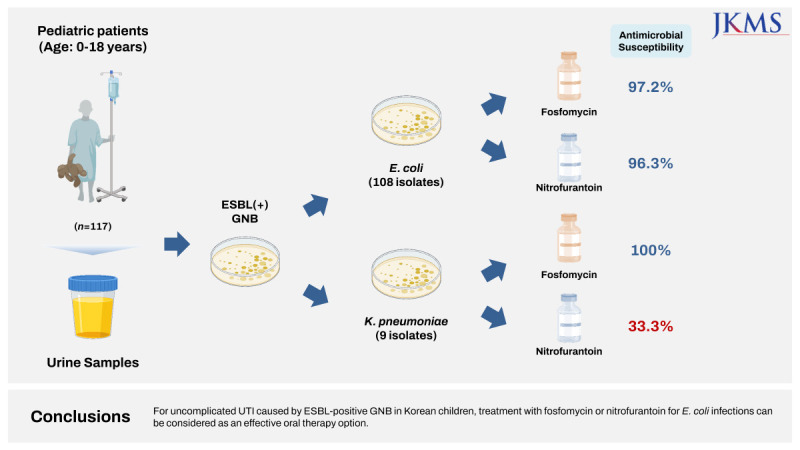1. Fan NC, Chen HH, Chen CL, Ou LS, Lin TY, Tsai MH, et al. Rise of community-onset urinary tract infection caused by extended-spectrum β-lactamase-producing
Escherichia coli in children. J Microbiol Immunol Infect. 2014; 47(5):399–405. PMID:
23834784.

2. Dayan N, Dabbah H, Weissman I, Aga I, Even L, Glikman D. Urinary tract infections caused by community-acquired extended-spectrum β-lactamase-producing and nonproducing bacteria: a comparative study. J Pediatr. 2013; 163(5):1417–1421. PMID:
23919903.

3. Topaloglu R, Er I, Dogan BG, Bilginer Y, Ozaltin F, Besbas N, et al. Risk factors in community-acquired urinary tract infections caused by ESBL-producing bacteria in children. Pediatr Nephrol. 2010; 25(5):919–925. PMID:
20151161.

4. Saltoglu N, Karali R, Yemisen M, Ozaras R, Balkan II, Mete B, et al. Comparison of community-onset healthcare-associated and hospital-acquired urinary infections caused by extended-spectrum beta-lactamase-producing
Escherichia coli and antimicrobial activities. Int J Clin Pract. 2015; 69(7):766–770. PMID:
25683907.

5. Ladhani S, Gransden W. Increasing antibiotic resistance among urinary tract isolates. Arch Dis Child. 2003; 88(5):444–445. PMID:
12716722.

6. Cheng MF, Chen WL, Huang IF, Chen JR, Chiou YH, Chen YS, et al. Urinary tract infection in infants caused by extended-spectrum beta-lactamase-producing
Escherichia coli: comparison between urban and rural hospitals. Pediatr Nephrol. 2016; 31(8):1305–1312. PMID:
26975387.

7. Lee YK, Lee H, Kim JM, Kang JM, Lee ST, Lee NY, et al. The antibiotic resistance pattern of gram-negative bacteria in children younger than 24 months with a urinary tract infection: a retrospective single-center study over 15 consecutive years. Child Kidney Dis. 2015; 19(2):148–153.

8. Subcommittee on Urinary Tract Infection, Steering Committee on Quality Improvement and Management. Roberts KB. Urinary tract infection: clinical practice guideline for the diagnosis and management of the initial UTI in febrile infants and children 2 to 24 months. Pediatrics. 2011; 128(3):595–610. PMID:
21873693.

9. Doi A, Shimada T, Harada S, Iwata K, Kamiya T. The efficacy of cefmetazole against pyelonephritis caused by extended-spectrum beta-lactamase-producing Enterobacteriaceae. Int J Infect Dis. 2013; 17(3):e159–e163. PMID:
23140947.

10. Tasbakan MI, Pullukcu H, Sipahi OR, Yamazhan T, Ulusoy S. Nitrofurantoin in the treatment of extended-spectrum β-lactamase-producing
Escherichia coli-related lower urinary tract infection. Int J Antimicrob Agents. 2012; 40(6):554–556. PMID:
23063743.

11. Neuner EA, Sekeres J, Hall GS, van Duin D. Experience with fosfomycin for treatment of urinary tract infections due to multidrug-resistant organisms. Antimicrob Agents Chemother. 2012; 56(11):5744–5748. PMID:
22926565.

12. European Committee for Antimicrobial Susceptibility Testing (EUCAST) of the European Society of Clinical Microbiology and Infectious Diseases (ESCMID). EUCAST Definitive Document E.DEF 3.1, June 2000: Determination of minimum inhibitory concentrations (MICs) of antibacterial agents by agar dilution. Clin Microbiol Infect. 2000; 6(9):509–515. PMID:
11168187.
13. Vachvanichsanong P, McNeil EB, Dissaneewate P. Extended-spectrum beta-lactamase
Escherichia coli and
Klebsiella pneumoniae urinary tract infections. Epidemiol Infect. 2020; 149:e12. PMID:
33327984.

14. CLSI. Performance Standards for Antimicrobial Susceptibility Testing, 32nd Edition. CLSI Guideline M100. Wayne, PA, USA: Clinical and Laboratory Standards Institute;2022.
15. Raphael E, Glymour MM, Chambers HF. Trends in prevalence of extended-spectrum beta-lactamase-producing
Escherichia coli isolated from patients with community- and healthcare-associated bacteriuria: results from 2014 to 2020 in an urban safety-net healthcare system. Antimicrob Resist Infect Control. 2021; 10(1):118. PMID:
34380549.
16. Seo MR, Kim SJ, Kim Y, Kim J, Choi TY, Kang JO, et al. Susceptibility of
Escherichia coli from community-acquired urinary tract infection to fosfomycin, nitrofurantoin, and temocillin in Korea. J Korean Med Sci. 2014; 29(8):1178–1181. PMID:
25120333.

17. Karlowsky JA, Denisuik AJ, Lagacé-Wiens PR, Adam HJ, Baxter MR, Hoban DJ, et al. In vitro activity of fosfomycin against
Escherichia coli isolated from patients with urinary tract infections in Canada as part of the CANWARD surveillance study. Antimicrob Agents Chemother. 2014; 58(2):1252–1256. PMID:
24323476.

18. Keepers TR, Gomez M, Celeri C, Krause KM, Biek D, Critchley I. Fosfomycin and comparator activity against select Enterobacteriaceae, Pseudomonas, and Enterococcus urinary tract infection isolates from the United States in 2012. Infect Dis Ther. 2017; 6(2):233–243. PMID:
28285420.

19. Raja NS. Oral treatment options for patients with urinary tract infections caused by extended spectrum βeta-lactamase (ESBL) producing Enterobacteriaceae. J Infect Public Health. 2019; 12(6):843–846. PMID:
31176606.

20. Jia P, Zhu Y, Li X, Kudinha T, Yang Y, Zhang G, et al. High prevalence of extended-spectrum beta-lactamases in
Escherichia coli strains collected from strictly defined community-acquired urinary tract infections in adults in China: a multicenter prospective clinical microbiological and molecular study. Front Microbiol. 2021; 12:663033. PMID:
34305831.

21. Perween N, Rai S, Nandwani S, Kumar SK 2nd. Retrospective analysis of urinary tract infection in the pediatric population at a tertiary care centre. Cureus. 2022; 14(5):e24796. PMID:
35677001.

22. Ko KS, Suh JY, Peck KR, Lee MY, Oh WS, Kwon KT, et al. In vitro activity of fosfomycin against ciprofloxacin-resistant or extended-spectrum beta-lactamase-producing
Escherichia coli isolated from urine and blood. Diagn Microbiol Infect Dis. 2007; 58(1):111–115. PMID:
17300900.
23. Tamma PD, Aitken SL, Bonomo RA, Mathers AJ, van Duin D, Clancy CJ. Infectious Diseases Society of America 2022 guidance on the treatment of extended-spectrum β-lactamase producing Enterobacterales (ESBL-E), carbapenem-resistant Enterobacterales (CRE), and
Pseudomonas aeruginosa with difficult-to-treat resistance (DTR-
P. aeruginosa). Clin Infect Dis. 2022; 75(2):187–212. PMID:
35439291.

24. Elliott ZS, Barry KE, Cox HL, Stoesser N, Carroll J, Vegesana K, et al. The role of
fosA in challenges with fosfomycin susceptibility testing of multispecies
Klebsiella pneumoniae carbapenemase-producing clinical isolates. J Clin Microbiol. 2019; 57(10):e00634–e00619. PMID:
31340992.
25. Huttner A, Kowalczyk A, Turjeman A, Babich T, Brossier C, Eliakim-Raz N, et al. Effect of 5-day nitrofurantoin vs single-dose fosfomycin on clinical resolution of uncomplicated lower urinary tract infection in women: a randomized clinical trial. JAMA. 2018; 319(17):1781–1789. PMID:
29710295.

26. Wald-Dickler N, Lee TC, Tangpraphaphorn S, Butler-Wu SM, Wang N, Degener T, et al. Fosfomycin vs ertapenem for outpatient treatment of complicated urinary tract infections: a multicenter, retrospective cohort study. Open Forum Infect Dis. 2021; 9(1):ofab620. PMID:
35036466.
27. Hatlen TJ, Flor R, Nguyen MH, Lee GH, Miller LG. Oral fosfomycin use for pyelonephritis and complicated urinary tract infections: a 1 year review of outcomes and prescribing habits in a large municipal healthcare system. J Antimicrob Chemother. 2020; 75(7):1993–1997. PMID:
32303061.

28. Purcell R, Wang N, Gwee A. Can fosfomycin be used for the treatment of Gram-negative urinary tract infections in children? Arch Dis Child. 2021; 106(9):925–928. PMID:
33461959.

29. Kara A, Gurgoze MK. The use of nitrofurantoin for children with acute cystitis caused by extended-spectrum B-lactamase-producing Escherichia coli. J Pediatr Urol. 2019; 15(4):378.e1–378.e5.
30. Murray TS, Peaper DR. The contribution of extended-spectrum β-lactamases to multidrug-resistant infections in children. Curr Opin Pediatr. 2015; 27(1):124–131. PMID:
25565574.

31. Purcell R, Yeoh D, Bowen A, Britton PN, Carr JP, Chen M, et al. A multicentre, retrospective audit of fosfomycin use for urinary tract infections in Australian children and adolescents. J Antimicrob Chemother. 2023; 78(7):1616–1621. PMID:
37190910.

32. Mayama T, Yokota M, Shimatani I, Ohyagi H. Analysis of oral fosfomycin calcium (Fosmicin) side-effects after marketing. Int J Clin Pharmacol Ther Toxicol. 1993; 31(2):77–82. PMID:
8458680.
33. Mikkelsen LF, Rubak S. Reversible lung fibrosis in a 6-year-old girl after long term nitrofurantoin treatment. BMC Pulm Med. 2020; 20(1):313. PMID:
33243181.

34. Falagas ME, Vouloumanou EK, Samonis G, Vardakas KZ. Fosfomycin. Clin Microbiol Rev. 2016; 29(2):321–347. PMID:
26960938.

35. Yang TY, Lu PL, Tseng SP. Update on fosfomycin-modified genes in Enterobacteriaceae. J Microbiol Immunol Infect. 2019; 52(1):9–21. PMID:
29198952.

36. Cattoir V, Guérin F. How is fosfomycin resistance developed in
Escherichia coli? Future Microbiol. 2018; 13:1693–1696. PMID:
30526061.
37. Lee SY, Park YJ, Yu JK, Jung S, Kim Y, Jeong SH, et al. Prevalence of acquired fosfomycin resistance among extended-spectrum β-lactamase-producing
Escherichia coli and
Klebsiella pneumoniae clinical isolates in Korea and IS26-composite transposon surrounding fosA3. J Antimicrob Chemother. 2012; 67(12):2843–2847. PMID:
22893681.








 PDF
PDF Citation
Citation Print
Print





 XML Download
XML Download